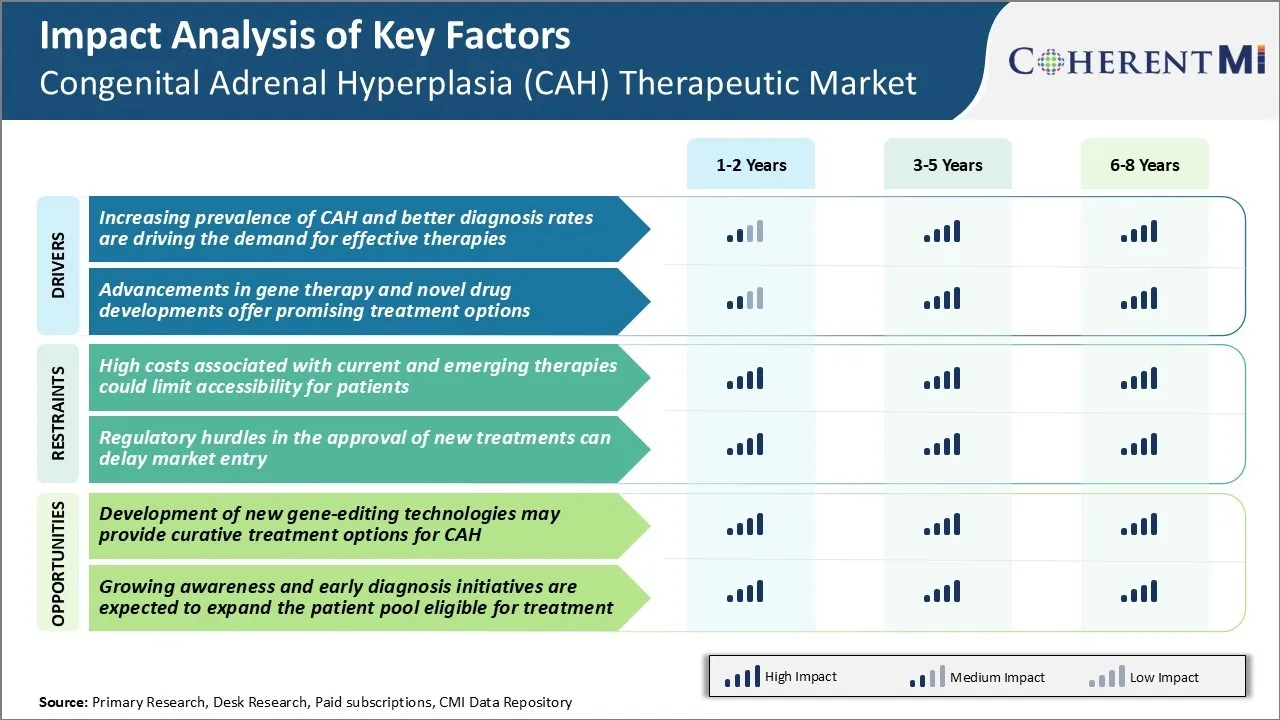Congenital Adrenal Hyperplasia (CAH) Therapeutic Market Trends
Market Driver - Increasing Prevalence of CAH and Better Diagnosis Rates are Driving the Demand for Effective Therapies
The prevalence of congenital adrenal hyperplasia has increased over the past few decades owing to greater awareness and improved diagnostic methods. With advancements in newborn screening using expanded diagnostic panels of 17-hydroxyprogesterone levels along with dried blood spot analysis, more regions worldwide have implemented mandatory CAH screening programs. This has led to the identification of asymptomatic or mildly symptomatic patients.
Additionally, specialized endocrinology centers focused on adrenal disorders have facilitated timely diagnosis through biochemical and genetic testing. Greater clinical understanding combined with diagnostic technologies have enabled diagnosis even for nonspecific or atypical presentations.
The increasing identification of CAH cases has amplified demand for effective long-term therapies. While glucocorticoid and mineralocorticoid replacement remains the mainstay of treatment, this approach is challenging with risks of over- and under-treatment. Non-compliance with complex medication dosing schedules also impacts outcomes. Younger generations diagnosed early require therapies throughout their lives.
Simpler and convenient delivery systems able to achieve tighter control of symptoms are highly sought after. Therapy individualization based on genotype-phenotype correlations also holds promise. The growing CAH patient pool worldwide reinforces the market potential for newer treatment paradigms offering superiority over existing options in terms of safety, effectiveness and ease of management.
Market Driver - Advancements in Gene Therapy and Novel Drug Developments Offer Promising Treatment Options
Scientists have made substantial progress in developing comprehensive understanding of CAH pathophysiology at the genetic and molecular levels. This expanding disease knowledge is being leveraged to engineer new treatment approaches. Gene therapy has emerged as an area of active investigation, mainly targeting gene variants responsible for the most common salt-wasting and simple virilizing forms of CAH.
Early phase clinical studies have reported proof-of-concept for delivering novel gene editing tools such as CRISPR/Cas9 to disrupt mutant alleles in steroidogenic genes. Researchers are focused on optimization of delivery vectors and control of transgene expression.
At the same time, pharmaceutical companies have accelerated drug discovery efforts driven by the unmet need. Compounds modulating key steroidogenic enzyme activity and cortisol synthesis through alternate pathways represent promising candidates. Clinical research is ongoing to establish medications able to induce stable remission of symptoms or restore near-normal hormonal profiles.
Combination therapies blocking excess androgens while substituting glucocorticoid deficiency are also under investigation. If successful, oral drugs could transform CAH management by offering more physiological control than lifelong hormone regimens. Their development would significantly boost the therapeutic market and benefit patients’ quality of life on a global scale.

Market Challenge - High Costs Associated with Current and Emerging Therapies Could Limit Accessibility for Patients
The costs associated with current and emerging treatments for congenital adrenal hyperplasia poses a significant challenge for widespread accessibility and adoption. CAH requires lifelong treatment and management, with therapies such as glucocorticoids and mineralocorticoids serving as the standard of care for controlling excess androgen levels and managing potential health impacts.
However, these current drugs often have issues with compliance and side effects from prolonged use. Emerging gene therapies and other novel treatment modalities also hold promise, but they are likely to have extremely high price tags that may place them out of reach for many patients and healthcare systems globally.
With CAH being a rare condition, pharmaceutical developers are less incentivized to make these new, potentially curative therapies affordable. This market vulnerability could significantly limit the number of patients who can benefit from the latest medical innovations.
For CAH to be properly managed on a societal level, collaborative efforts between industry, regulatory authorities, and patient advocacy groups will be needed to help ensure adequate access to existing and future treatment options is possible through various pathways.
Market Opportunity - Development of New Gene-Editing Technologies may Provide Curative Treatment Options For CAH
Significant potential now exists for gene-editing technologies like CRISPR to transform the treatment landscape for congenital adrenal hyperplasia (CAH) from a lifelong management to a potential one-time cure. CAH is caused by mutations in the CYP21A2 gene, disrupting the production of cortisol and often leading to excess androgen levels.
Early research efforts are now exploring how to utilize CRISPR and related tools to precisely modify or replace the defective gene, repairing the underlying cause of CAH at its source within the patient's own cells and tissues. While still in preclinical development, continued progress in this area could lead to novel therapies that restore healthy cortisol levels without requiring chronic medication use.
This would undoubtedly improve long-term health outcomes and quality of life for CAH patients. It could also be commercially transformative for pharmaceutical developers by supporting curative pricing models different than traditional drugs. As the science advances, gene editing holds immense promise to inaugurate an exciting new era defined by potentially one-time cures for certain genetic conditions like CAH.